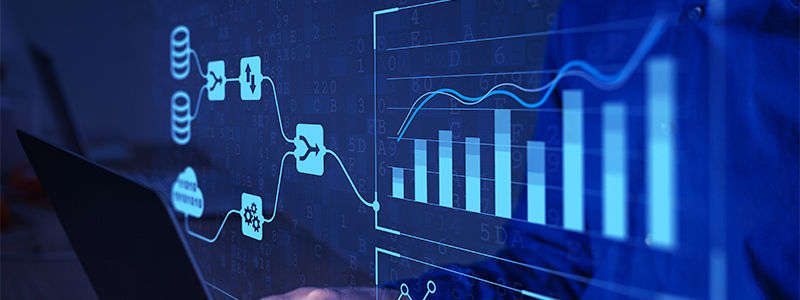
Top 10 Data Replication Software in 2025
Every day, we hear news about data getting hacked or lost. Imagine losing data in this era where everything is dependent on it. That’s why investing in good data replication software is important to back up your data. Well, that’s just one example of a data replication use case.
Data replication software are used in multiple scenarios, so there is no surprise that, according to IDC, the data replication software market is expected to grow at a 3.6% CAGR through 2026.
This article navigates through the top 10 data replication software available in the market and explains their pros and cons so you can choose the right one.
The Importance of Data Replication Software
Data replication involves creating and maintaining multiple copies of crucial data across different systems or locations. It ensures high data availability by allowing you to access your data from several sources, such as servers and sites, in real time. However, data replication can be complicated and time-consuming, so most organizations employ data replication software.
These tools are designed to streamline the intricate process of manual data replication. They not only automate the process but also ensure it is error-free. Here are some of the benefits of using data replication software.

Improve Data Accessibility: The best part about data replication tools is that they automate copying and maintaining data across various locations. These tools make this process far easier and manageable even for those with limited technical expertise, as most tools are now code-free and come with a user-friendly interface.
Help Implement Disaster Recovery Plans: Data loss due to unexpected events like natural disasters or human error can be catastrophic for a business. Data replication tools create exact copies of data across different sites, acting as a safety net. If a disaster occurs, a company can use the replicated data to restore systems quickly, thus minimizing business disruptions and preserving data integrity.
Increase Scalability: Data replication tools are designed with scalability in mind. They distribute queries among multiple databases and balance the load so systems can handle higher requests without slowing down. This scalability is particularly beneficial for growing businesses that experience increasing data traffic.
Enable Real-time Analytics: Data replication tools continuously synchronize data across all systems, ensuring that analytics tools always work with real-time data. Whether reacting to sudden market shifts or adapting to customer demands, real-time analytics powered by seamless data replication empowers businesses to act swiftly and precisely.
Facilitate Global Operations: When a business operates internationally, it also needs to have data available on local systems. Data replication tools allow companies to distribute data to be accessed from various geographical locations. This reduces latency, improves speed, and ensures smooth operations across different regions.
Enhance Data Security Protocols: Modern data replication tools copy data and protect it during the replication process. They are equipped with secure channels and utilize advanced encryption techniques, which reduces the risk of cyber threats and breaches. In an attack, the replicated copies can act as a secure backup.
Simplify Testing Environments: Rigorous testing is essential in developing and deploying new applications or systems. With data replication tools, you can create isolated testing environments where replicated copies of data are used. This approach maintains the integrity of the original data and enables more comprehensive and accurate testing.
The 10 Best Data Replication Software in 2025
Having already discussed the different benefits of data replication software, let us now dive into the other data replication software available today.
1) Astera Data Pipeline Builder
Astera Data Pipeline Builder is an enterprise-grade, AI-powered data management solution with powerful no-code data replication capabilities. It simplifies designing, deploying, and automating data pipelines and helps you streamline your data-driven initiatives.
Key Features of Astera Data Pipeline Builder
User-Friendly UI: Astera is a completely code-free ETL tool with powerful functionalities designed for both business users and IT experts. Everything in the tool is available at a drag and drop, which makes it easier for all users to take charge of their data-driven initiatives.
AI-Driven Data Accuracy: Uses AI-powered semantic mapping to ensure accurate and consistent data replication.
Wide Range of Source and Destination Types: The software offers built-in connectors for various file formats, databases, and cloud storage platforms. You can use the tool to easily replicate your data in various destinations such as other databases and data warehouses.
Data Transformation and Validation: Astera features a library of in-built transformations and functions, so you can easily manipulate your data as needed. It also helps with data quality management to ensure the accuracy and completeness of your data. Custom validation rules allow advanced profiling and debugging to identify and fix data anomalies.
Change Data Capture: The tool also offers change data capture capabilities helpful in replicating data from transactional databases to analytical databases. Change data captures allow you to replicate only the data unavailable in the destination, which speeds up your data analytics.
With CDC, you can ensure that your resources are not held up at certain times of the day or week because instead of loading data into your data warehouse in large batches and querying large volumes of data in one go, you can do so as and when it is received.
Smart Match Feature: This feature significantly facilitates data replication. When this feature is enabled, Astera Data Pipeline Builder checks for alternative headers specified in the synonym dictionary file. So, for example, in one file, the number is written as “Number,” and in the other it is written as “No”, Astera will check for both.
Workflow Scheduling: With Astera, you can design and schedule dataflows in a workflow for automated and repeated execution. The tool offers trigger-based job scheduling to schedule workflows according to time or events.
Strong Security: Astera knows the importance of data security and hence offers robust security features such as role-based user access and authentication.
2) Qlik Replicate
Qlik Replicate is known for various data movement tasks, including replication, synchronization, distribution, consolidation, and ingestion. It’s tailored to work with multiple databases, data warehouses, and big data platforms on-site and in cloud environments. The platform claims to offer high performance and scalability with its approach to handling high throughput and low latency.
One feature that potential users might appreciate is its graphical interface, which is designed to simplify tasks that might otherwise require manual coding.
While Qlik might be a good tool for data replication, reviews indicate integration difficulties with certain APIs and databases. Moreover, the tool delivers its best when used alongside other products from Qlik’s suite. While it promotes itself as user-friendly, some scenarios highlight the importance of having seasoned professionals for practical use
3) IBM Data Replication
IBM Data Replication helps synchronize data in real-time across different data stores, both on-premises and in the cloud. It tracks and captures database changes as they happen and delivers them efficiently, almost in real-time. Additionally, it helps reduce the impact of unexpected outages and database migrations by enabling automatic switching to a backup system with minimal downtime.
The software can capture changes from a variety of database types and deliver them to multiple destinations, including other databases, message queues, big data, and ETL platforms. It is available in several formats: as a standalone software, as a software-as-a-service (SaaS), within IBM’s Cloud Pak for Data, and as a cartridge for Cloud Pak for Data.
While the software is well received, the initial setup can be a tad bit complex, particularly with specific databases, such as Teradata, which leads to latency issues, necessitating configuration adjustments.
4) Lyftrondata
Lyftrondata is a data replication software tailored for large-scale data distribution across multiple hosts and systems. Its design simplifies data loading, transfer, and replication processes across diverse platforms. An essential capability of the software is real-time synchronization, which is instrumental for consistent replication and application of incremental changes from multiple sources to destinations like Amazon S3, RDS, or Redshift.
While Lyftrondata aims to enhance network performance, expedite data processing, and ensure robust disaster recovery measures, the software is not easily customizable. Some users might also find its interface a little complex, which means a steeper learning curve and a need for training, especially for business users.
5) Oracle GoldenGate
Oracle GoldenGate, integrated with Oracle Cloud Infrastructure (OCI), is a data mesh platform tailored for real-time data movement. Its adaptability extends to different databases, and its varied architectural models cater to an array of organizational data needs.
However, mastery of GoldenGate demands a niche skillset, and its efficiency wanes when handling large data objects like CLOBs and BLOBs. Maintenance complexity can also rise with the addition of replicate groups.
6) Hevo
Hevo is a code-free ETL tool that also offers data replication capabilities. It provides seamless data synchronization across various connectors, including databases and data warehouses. The tool provides an easy-to-use interface. You can use it to quickly ingest data, transform it, and replicate it into the destination of your choice.
While Hevo can be a good choice for data replication, one thing to note is the pricing of this product. The product offers event-based pricing, which means that your bill will increase with the amount of data you replicate. So, it might not be the right choice if you are a large business that must replicate a large data volume. Also, Hevo doesn’t roll over the credits every month. So, if your credits expire, then you lose them.
7) Syniti
Syniti is another data replication software that ensures high availability by replicating data to secondary systems or locations. It has various features such as data mapping, transformation, change data capture, and orchestration. The tool also provides a centralized dashboard for monitoring the replication process, tracking data synchronization, and managing configurations.
Although Syniti comes with a graphical user interface, it is designed for data management experts and has a steep learning curve.
8) Veeam Backup & Replication
Veeam Backup & Replication is designed for backup-based replication, ensuring high availability and disaster recovery across hybrid and multi-cloud environments. It supports physical, virtual, and cloud-based workloads. Key features include incremental backups with changed block tracking, native integration with AWS, Azure, and Google Cloud, and instant VM recovery.
However, the licensing model can be expensive, especially for organizations with large-scale deployments. While the platform offers extensive features, the setup process can be complex, requiring technical expertise to optimize configurations. Additionally, backup performance may vary depending on storage infrastructure.
9) DRBD (Distributed Replicated Block Device)
DRBD is an open-source, block-level replication solution for real-time data mirroring across Linux-based clusters. It is widely used for high-availability (HA) applications, ensuring that data remains accessible even in case of hardware failures. It features include low-latency replication, automatic failover, multi-node replication, and support for RAID-based configurations.
Note that DRBD’s setup and configuration require in-depth Linux knowledge, making it less accessible for users unfamiliar with system-level management. Additionally, DRBD is primarily designed for Linux environments, limiting its adoption for organizations that operate in mixed-OS environments.
10) Altibase
Altibase is designed for mission-critical applications in industries such as finance, telecommunications, and manufacturing. Key features include active-active replication for zero-downtime failover, multi-version concurrency control (MVCC), and support for SQL and NoSQL workloads.
On the other hand, Altibase’s proprietary licensing model can be costly for some businesses. The platform requires specialized knowledge to manage and optimize, making it less beginner-friendly. Additionally, while its hybrid storage model offers flexibility, improper configuration can lead to suboptimal performance.
How to Choose the Right Data Replication Software
Once you’ve decided to purchase data replication software, you must thoroughly vet each tool available to make the right choice. While the right tool may differ for every business depending on its use case, there are some universal aspects that you should keep in mind:
- Compatibility: The software’s compatibility with your existing systems, databases, and platforms is very important. You should check if the software works well with the type of data that you have. Ideally, the tool should be able to support various data types and handle different data formats, structures, and sources.
- Real-time replication: If you, like most businesses today, require up-to-date data across systems, a real-time image would be essential. It is vital to ensure the tool can capture and replicate changes as they occur to support integration and accessibility.
- Scalability: Choosing a tool that won’t cause problems if your business grows exponentially is paramount. Good data replication software will maintain high-performance replication, even at much higher volumes of data, ensuring low latency and consistency.
- Customization: Make sure to choose software that can be customized according to your specific needs. Look for the ability to filter, transform, and map data as it is replicated, as well as the ability to configure replication schedules and rules.
- Security: The tool should provide robust security features to protect your data during replication and at rest. Some must-have security features include secure authentication mechanisms, access controls, permissions, etc.
- Ease of Use: A tool with a steep learning curve can prove to be problematic; you must look for a device that has an intuitive, user-friendly interface so that it has a slight learning curve for your team. Try to go for a tool that is code-free and comes with a drag-and-drop functionality.
- Costs: Finally, you must also make sure that the tool’s benefits outweigh what it’s going to cost you. Costs can include maintenance, licensing, support, training, any necessary hardware or software updates, etc.
Astera Data Pipeline Builder: Your AI-Powered Data Replication Software
Having a powerful data replication software has become a necessity these days.
If you’re seeking an all-encompassing, user-friendly solution, Astera Data Pipeline Builder is worth considering. As an AI-powered, cloud-based data integration tool, ADPB doesn’t merely replicate data — it transforms it into actionable insights quickly and efficiently.
This ability to cleanse, transform, validate, and load data into a single, consolidated repository means you can focus more on deriving value from your data and less on the complex processes of preparing it. Whether you need to synchronize transactional records, consolidate customer data, or ensure compliance with regulatory requirements, Astera Data Pipeline Builder provides the flexibility and automation required to maintain accurate, up-to-date information.
Remember, the right tool will simplify your data replication tasks and pave the way for a more data-informed business approach. With Astera Data Pipeline Builder, that capability is within your reach. Its cloud-based scalability and real-time processing capabilities make it a future-ready solution for enterprises of all sizes.
Download a free 14-day trial and try it for yourself.
What is data replication software?
How does data replication software work?
What are the key features of data replication software?
What are the types of data replication?
The primary types are:
- Transactional Replication: Replicates individual transactions as they occur.
- Snapshot Replication: Copies data at specific points in time.
- Merge Replication: Combines data from multiple sources, allowing changes from different databases to be merged.
 Astera AI Agent Builder - First Look Coming Soon!
Astera AI Agent Builder - First Look Coming Soon!



